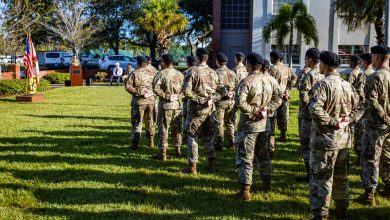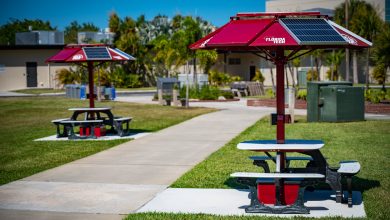Florida Tech Joins Forces with Brevard Zoo to Re-home Endangered Spider Monkey
F.I.T. Aviation, College of Psychology and Liberal Arts and School of Psychology members all played a role in rescuing the baby monkey from a likely future in the illegal wildlife trade
Drugs, money, weapons, merchandise—you name it, and U.S. Customs and Border Protection officers have likely come across someone attempting to smuggle it into the country.
So, when officers found a 6- to 7-month-old spider monkey hidden in the center console of a white pickup truck attempting to cross the Texas-Mexico border June 23, they may have found it unusual, but unfortunately, not unheard of.

A Tragic Backstory
What was the monkey doing in a 23-year-old man’s truck?
“The real answer is, we don’t know because we don’t have that backstory,” says assistant professor Darby Proctor, who also works at Brevard Zoo studying spider monkeys. “However, in cases like this, the most frequent scenario is that a poacher goes into the forest, they shoot the mom for bush meat … then, they take the babies to sell into the illegal pet trade.”
These infants are often then sold as pets to families in the U.S. for large sums of money.
In fact, following drugs, weapons and human trafficking, the illegal wildlife trade is the fourth most lucrative transnational crime, according to the Wildlife Trafficking Alliance.
There is a reason, though, that exotic animals, like spider monkeys, are not intended to be pets.
“They need other monkeys. They need to be social,” Proctor says. “They have very complex social needs that humans simply cannot provide for them. They need to be with other monkeys.”
So, when officers contacted the U.S. Fish and Wildlife Service, they brought him to be quarantined at Dallas Zoo.
During those couple months of quarantine, word of the situation spread to the Association of Zoos and Aquariums Species Survival Plan, a population management and conservation program for select wildlife species, which immediately started searching for potential homes.
Finding a Home
Because spider monkeys aren’t domesticated, many question why officials wouldn’t simply release them and other exotic animals in similar situations back into the wild.
“If we put this guy back in the wild, he would be dead in a matter of days,” Proctor says. “That’s just not an option. Again, we all wish he had never been taken out of the wild, but he was. Now, we’re at the point—What can we do for this monkey to give him the best life we possibly can?”
We all wish he had never been taken out of the wild, but he was. Now, we’re at the point—What can we do for this monkey to give him the best life we possibly can?
Darby Proctor, assistant professor, School of Psychology, Florida Tech
The answer: Integrate him into another group of monkeys, she says.
That is why the Species Survival Plan contacted Brevard Zoo, where Proctor recently developed a spider monkey cognitive testing complex and conducts research alongside fellow animal behavior psychologist and assistant professor Catherine Talbot and their students.
This ideal spider monkey habitat is also home to Shelley, the troop’s alpha female who has an infant about the same age as the rescued monkey and who, they’d hoped, would essentially adopt him.
After permits were pulled and paperwork was filed, everything was in place. Well, almost everything.
Location? Check.
Adoptive family? Check.
Team of enthusiastic researchers to assist with the transition? Check.
Only one question remained: How do we get him here?

The Journey
Typically, in situations like these, researchers rely on commercial airlines to transport various species. However, airlines at the time were not flying nonhuman primates, as they, like humans, are potential COVID-19 carriers.
Since the monkey had already been separated from other monkeys for at least half of his life, the longer he remained in seclusion, the more detrimental researchers feared it would be to his eventual reemergence into monkey society.
They needed a solution—and quick. Thankfully, Proctor had one: her Florida Tech colleagues at F.I.T. Aviation.
“We have planes. We have pilots. Maybe there’s a way we could make this work,” Proctor recalls thinking.
After much coordination between Florida Tech’s School of Psychology, College of Psychology and Liberal Arts and F.I.T. Aviation, Brevard and Dallas zoos and the Species Survival Plan, the rescue mission was set.
On Sept. 17, Shayne Inniss ’16, ’19 MSA, and Zachary St. Amand ’19, both F.I.T. Aviation pilots, took off from Orlando Melbourne International Airport with Dave Quavillon, curator of animals at Brevard Zoo, in a Florida Tech Piper Seminole—the same plane in which aviation students learn to fly.
“I thought it was a pretty cool thing,” Inniss says. “It gives me a chance to see another side of aviation, where you’re actually fulfilling another purposeful mission. … I think it’s a really cool opportunity for not just myself, but also Florida Tech.”

After making stops to refuel in Panama City Beach, Florida, and Baton Rouge, Louisiana, the crew landed in Dallas seven hours later.
The next morning, they went to Dallas Zoo, collected the spider monkey, reboarded the airplane, took off and landed back at the Melbourne airport with a safe, albeit exhausted, fourth passenger: the baby spider monkey.
“The curator told me that he was alert and looking around for most of the flight,” Proctor says. “He was checking things out. When he arrived at the airport, of course, we immediately took him to the zoo and got him into his temporary home.”
The Transition
After much rest and rejuvenation, the monkey quickly regained his spirited demeanor, moving around, climbing and doing more “monkey things.”
While Dallas Zoo had worked with him and fed him an appropriate diet while he was in quarantine, his muscles looked a little underdeveloped, which Proctor attributes to his not needing to cling onto his mother like he would in the wild.
“We were trying to get him to move around a lot more, climb more, so that he can build up some of that musculature before we get him fully integrated in with our group,” she says. “Because we do want him to be able to keep up and climb and move around as much as they do.”
Within a couple days of his transportation, Proctor and Talbot were ready to introduce the new monkey, later named Mateo, to Shelley and her baby, confident that Shelley would take him in because she has always been such a good mother.
Too good of a mother, it seems.
“It turns out, Shelley is such a good mom that she wouldn’t let her current infant get anywhere near this stranger infant,” Proctor says. “Our best laid plans went out the window.”
They also found that, while they had planned to face obstacles regarding other monkeys in the troop being hesitant to accept the new monkey, they hadn’t taken into consideration that Mateo might not immediately take to the others.
“What we very quickly realized is that he is afraid of other monkeys. He hasn’t seen one in a long time. He probably doesn’t even understand that he is a monkey,” she says.
Daisy, a friendly 3-year-old monkey in the group, is ready to play with Mateo, even offering him a few hugs, which mean exactly the same thing to monkeys as they do to humans, Proctor says. Mateo, however, has been hesitant.
“We’re having to really go slowly with him to teach him that the other monkeys are safe, that they are potential playmates for him. He’s been making really good progress each day, but it is going to take a lot longer than we anticipated.”

Credit: Emily Almodovar Warner, Florida Tech student
What’s Next?
While every monkey—just like every human—is different, determining what behaviors or reactions to anticipate and deciding what steps to take in response to them has been particularly challenging throughout this integration process, as no similar studies have been published.
Proctor and Talbot, however, plan to publish their research regarding the integration process—what worked, what didn’t and how they proceeded—in the hopes that it might help institutions in future similar situations, even if just as a starting point.
Their ultimate hope for Mateo is that he will, eventually, fully integrate with the group. Based on what they’ve observed in the just three weeks since his arrival at Brevard Zoo, they’re hopeful.
“The first few days, he was really hiding. But now, he’s coming out; he’s playing,” Proctor says. “At least when he’s by himself, he’s acting like a baby monkey, which is great. It’s such dramatic improvements from the first few days.”
After scrambling to assemble a transportation plan, developing the first steps in an integration plan and promptly scrapping them when things didn’t go as anticipated, Proctor and team have a new plan.
“We are running on his time now. We have no deadlines. That deadline is when he’s ready. We’re just going to take things at his pace and keep hoping to see that slow and steady improvement.”

Credit: Florida Tech student Emily Almodovar Warner





